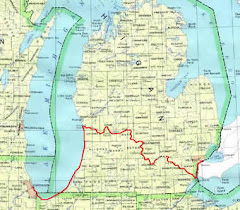Continuing with my 1999 article in "Michigan History":
LaSalle's party, which included four coureurs de bois and one Native American, a Mohegan Indian named Saget, left Fort Miami on March 25, 1680. According to LaSalle, after crossing the flooded St. Joseph River (then called River of the Miamis) on a raft, the men "...continued our march through the woods, which was so interlaced with thorns and brambles that in two days and a half our clothes were all torn and our faces so covered with blood that we hardly knew each other."
Thanks to the efforts of three Western Michigan University Professors, we know what the nature and extent of the forest cover was like three hundred years ago in southwestern Michigan. In 1984 Lawrence G. Brewer, Thomas W. Hodles and Henry A. Raup from the Department of Geography published a map entitled Presettlement Vegetation of Southwestern Michigan. They created the map based on upon field notes of the early-nineteenth-century surveyors who moved through a wilderness little changed from that which existed in the late seventeenth century. As part of their job, the surveyors located and identified the types of trees and terrain that existed in Michigan before it was disturbed by the pioneer's axe or plow.
After two and a half days in the briars and brambles, LaSalle's party came out of the Paw Paw River valley and "found the woods more open". But where?
About sixty years ago (seventy now) University of Michigan professor Clifford H. Prator concluded that LaSalle broke into the open woods somewhere in the northwest corner of Kalamazoo County. Trying to follow Prator's suggested route today takes one into the extensive mucklands in the northeast corner of Van Buren County. In the late seventeenth century this was one big swamp. Furthermore, modern topographic maps and road reconnaissance show the party then would have encountered difficult "knob and kettle" terrain where level land is virtually nonexistent. On the other hand, road reconnaissance around the upper end of the north branch of the Paw Paw River about seven miles south of there leads to the area of the Wolf Lake state Fish Hatchery and east up to high ground--about where Highway M-43 climbs up the ridge known to geologists as the Kalamazoo Moraine. This is close to the Van Buren-Kalamazoo county line. The Presettlement Vegetation map shows that this was a transition area from a southern swamp forest to an oak savanna. This is consistent with LaSalle's account of emerging from the briars and brambles and finding the woods more open.
I believe LaSalle actually traveled through oak savannas and forests and the relatively benign terrain of what is now the northern half of Kalamazoo County's Oshtemo Township (approximately along the route of M-43). If LaSalle and his party were on this route, they would have reached Grand Prairie within an easy five-mile walk after leaving the Paw Paw River valley. Grand Prairie was located just west and northwest of present-day Kalamazoo.
Hunger and the abundance of game made the party careless. The sounds of their guns and the trail of partially butchered carcasses attracted an Indian war party, and nearly led to disaster.
NEXT: Surrounded by Indians.


No comments:
Post a Comment